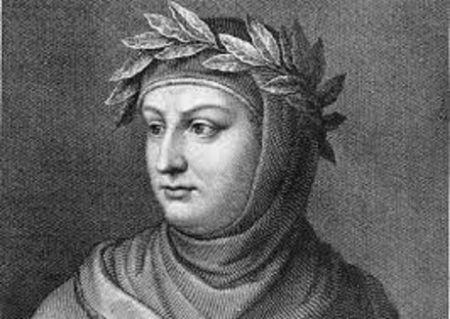
Giovanni Boccaccio author of The Decameron by Raffaello Morghen, circa 1822
“And the plague gathered strength as it was transmitted from the sick to the healthy through normal intercourse, just as the fire catches on to any dry or greasy object placed too close to it. Nor did it stop there: not only did the healthy incur the disease and with it the prevailing mortality by talking to or keeping company with the sick–they had only to touch the clothing or anything else that had come into contact with or been used by the sick and the plague evidently was passed to the one who handled those things.”
― Giovanni Boccaccio, The Decameron
Here we go again, I thought as I started to re-read Boccaccio’s Decameron, just as all the libraries closed down their doors and I was left with a pile of books I couldn’t return. To be stuck with Boccaccio is not bad, not bad at all. One cannot fail to notice similarities of times long gone and today’s events. Giovanni Boccaccio wrote a masterpiece, and a very accurate overview of the human condition. The Decameron is the most vivid account of societal breakdown in the times of The Black Death (written between 1348-1353). He captured the complexity of human nature, value systems, reality of life and earthy pleasures. I’m certain that I’m not the only one to savor the same book yet again in 2020 – not only because of the quality of its prose, its precision and elegance, but because I needed to reassure myself that regardless of Quarantine-induced confinement, life HAS meaning and joy CAN be a part of it. Yes, even during these strange times, and unexpected circumstances. Times and customs of the world might change, but the range of human emotions, strengths-and-weaknesses – remains the same. Historia magistra vitae est – old Latin proverbs, learnt by heart decades ago, resurfaced in my mind.
The Decameron resonates with us today more than ever: human nature is constant, and history repeats itself. You can learn a lot about the ways people behave in challenging situations in life just by reading The Decameron – even about people that tried to profit from the unfortunate situation. Boccaccio himself had managed to escape The Black Death, although it had killed one-third of the population of Italy and caused financial devastation of a large scale, so it’s very easy to draw parallels. Another thing that Boccaccio underlines is also valid today: all levels of the society suffer(ed) the same. Florentines reacted to the threat differently; there were those who ran away to the outskirts of the city, isolating themselves with close friends and family members, and enjoyed fine food and wine, music, art, and reading. Then there were those who stayed in Florence, deciding to live like there’s no tomorrow, enjoying wild parties – all the possible vices included.
There were also citizens that took a middle path, tried to preserve their sanity while carrying around herbs and wearing long coats as protection. And then there were the poor: Boccaccio notes that thousands of lives were lost, those who died from malnutrition, inadequately housing, and because they couldn’t afford to leave the city at all.
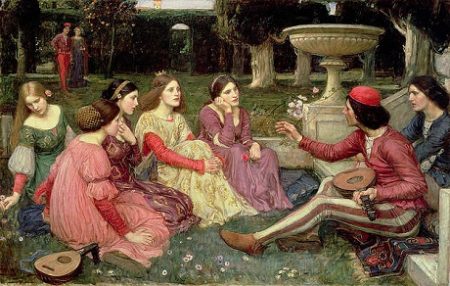
The Decameron Painting, John William Waterhouse
Let’s take a closer look at the ones that got away, because the Decameron novel consists of 100 tales – told by seven young women and three young men that range from the romantic to erotic. This merry bunch had fled the city of Florence during the plague to live in isolation for 40 days (Quarantine, literally) in the safety and beauty of the nearby Tuscan countryside.
Each member has a turn as being a king or queen over others for a day, and to decide how will they spend their day. Their storytelling is alternate: 10 people tell stories over 10 days, hence Decameron (ten day’s work). While the plague, and the moral and social chaos that accompanied it rage in the most beautiful city of Florence, the protagonists of The Decameron are enjoying witty conversations, playful adventure which are retold in their stories, and quite a few great comic scores. I adore stories of days VII, VIII, and IX, dedicated to laughter and trickery: oh, laughter! We need laughter!
Worldy pleasures were not unknown to post Middle Age – early Renaissance bourgeoisie women and men; the new humanist approach suggested even then that a person might well enjoy life without offending God, and our merry bunch surely enjoyed secular goods such as art, fine food and clothing…and fragrance.
Even the Black Death and Plague doctors tried to surround themselves with scents. They are famous for their bird-beak masks, that resemble bio-hazard gas masks of today. These doctors had been working in their trade since the Middle Ages, but it was only during the 17th century that they acquired their trademark costume.
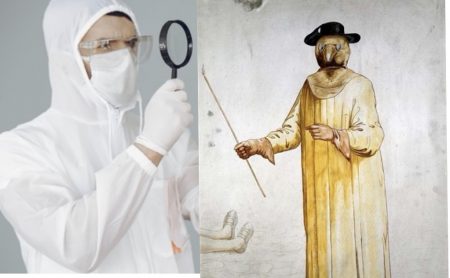
The Doctor’s Mask Today vs 17th Century, collage by Elena Cvjetkovic / Pexells
These bird-like masks were often filled with lavender, dried roses and carnations, mint, spices, and camphor (they must’ve smelled way better than masks we are wearing – there’s an idea for masks producers: why not fill the folds with the same ingredients?). Doctors of that time believed strongly that herbs would counter the foul smells of the plague and keep them safe from infection. And let’s not forget that the bubonic plague kept returning in Europe: The Black Death period occurred between 1346 and 1347, came to stay, and hit over and over again over time, until the early eighteenth century.
It has been stated many times that the other function of scent during that era was to cover ghastly odors. The “body odor“ issues came about at that time because the Black Death brought great fear to people- the fear of water. Public baths were closed and people really believed that water was a gateway for the disease to enter their bodies. Smelling good became a sign of class and to douse in perfume, potent, powerful, and strong became a habit.
Talk about “beast mode“fragrances? Well, they had a good reason to prefer XXL sillage and projection and to splash abundantly, to bathe in them: perfumes were used to cover up the stench, and not to enhance your overall presentation, nor to express mood and feelings, or to send a particular message. And yes, they did enjoy various scented products – not complicated in form and composition but still – fragrant. Fragrance is and was an inseparable part of human life. Always, even in the darkest moments of human history!
All taken into account, together that at that time valerian, musk, civet, amber, clove, jasmine, rose-water, citrus blossoms, lavender, herbs, and tuberose were aristocrat and bourgeoisie “approved”, let’s consider which more modern perfumes would suit some characters and scenes from the Decameron.
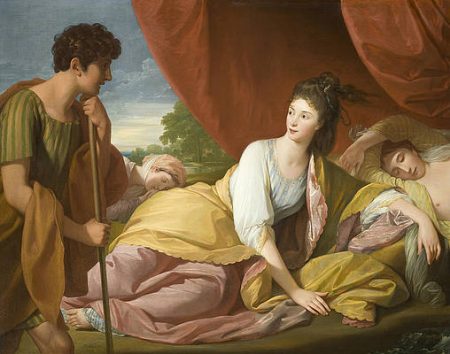
Cymon and Iphygenia, painting by Benjamin West
Which fragrance could possibly be Fiametta’s, Filostratos’, or Pampinea’s signature scent? What was the scent of their bedrooms? Of the food they ate? How could have the forest where they danced, or the garden where they gathered smelled like?
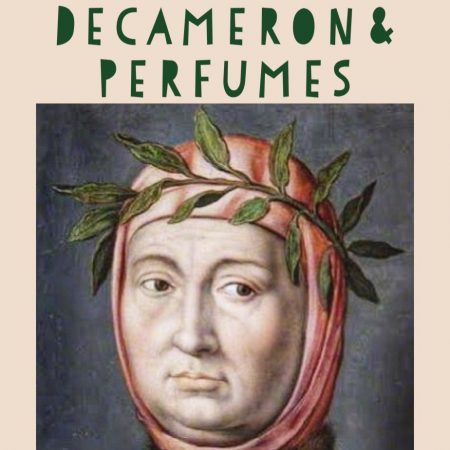
Every time I read the Decameron, I pair fragrances with the characters and places, the scenery, and situations described. Let’s take a closer look at what could be the “…most odoriferous and could possibly yield so sweete a savor.“ My mission was to find perfumes to correspond with terroir, atmosphere and characters.
Mise-en-scène~Stories of the Third Day: sex, voice, and morals. On the beautiful Sunday, our storytellers move to a special place: a palace, adjoined by a lush garden. This garden is described in the Introduction: full of exotic fragrances, suggestive of spices of the East, and has an exquisite design. “If Paradise was constructed on Earth, this would be it. A perfect place, for perfect love.“ All ten stories of the Third Day and Paradise Lost are dedicated to masculine-feminine relations, and not quite innocent ones at all: each novella raises questions about different sexual relations. Necessary “Gardening“ described here doesn’t refer to flora only… Scents described include orange and lemon blossoms, jasmine, white and red roses, spices, woods.
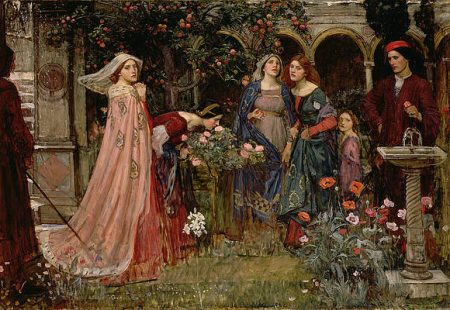
The Enchanted Garden Painting, John William Waterhouse
Acqua Colonia Rosa Novella Santa Maria di Novella Perfumes: My first association was immediately Rosa Novella, from the house of Santa Maria di Novella Perfumes, and brings back memories of all my visits to their flagship store in Florence.
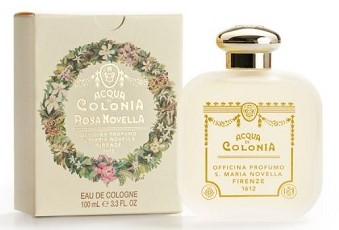
photo by Santa Maria di Novella
A very romantic May rose from Tuscany, fresh and flowery. It’s so easy to imagine it blooming in the gardens of the Santa Maria di Novella, under the specific blue color of sky above Florence. A cabbage rose at it’s finest, almost a soliflore. Refreshing and sensual at the same time, and so befitting the imagery from the book of strolling carelessly around a garden and inhaling deeply the sweet, fresh, soft and slightly spicy fragrance of roses and other spring flowers in full bloom. Timeless and uplifting, soothing, and playful. So youthful, and yet so ancient at the same time.
Notes: lemon, petitgrain, rosa centifolia, white flowers, spicy aromatic notes, patchouli, sandalwood, cedarwood, musk.
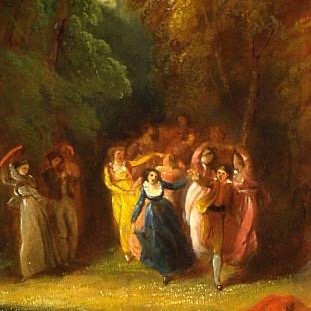
A Scene From the Decameron, painting by Thomas Stothard
Mise-en-scène~ Ninth Day, under the rule of Emilia: there are no prescribed themes for the Decameron stories. Quite a few are about cunning tricks performed, and – of course, some lascivious ones. Location: old woods not far away from the palace. When the protagonists of the book had returned to their quarters, they were all “garlanded with oak leaves, and their hands were full of sweet-scented herbs and flowers, and anyone who had come across them would have thought: “Either these people will never be overcome by death, or else they will die happy.“ Scents described: green, bright notes, herbs, flowers, oak leaves.
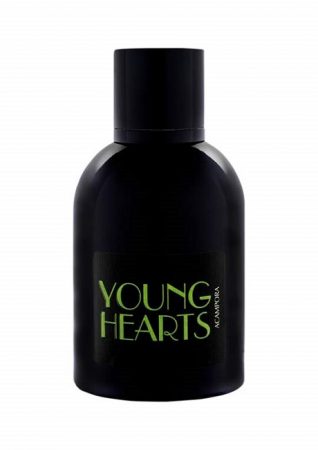
Young Hearts, photo by Bruno Acampori
Young Hearts, Bruno Acampora/ Miguel Matos (an Art&Olfaction Awards 2020 Finalist): Green it is, and also a classic-structure Chypre-green, joyful and bursting at its seems. It could very well fit into 1470s, or anytime, even if inspired by 1970s: a very natural and fresh opening, with tree branches and pink roses rolling around in oakmoss. And a pinch of saffron, just to mess up the greens a bit – and let me tell you one little secret: saffron here is the key to unlock all the facettes of this fragrance, to understand all the directions it pulls in. Intensely green, slightly bitter, and earthy galbanum perfectly fits and prances around with patchouli, and it smells like unrestrained laughter coming from a party set in woods. A wild party it was, the kind that makes you feel alive and happy, drunk with fresh air, and high on serotonin – the “happy“ chemical.
Notes: Bergamot, galbanum, birch leaf, pine, saffron, jasmine, fir balsam, rose, oakmoss, patchouli, musk, amber.
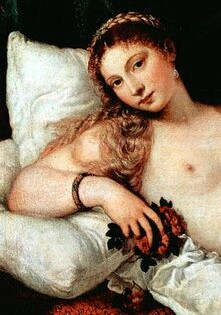
Venus of Urbino by Titian (detail)
Mise-en-scène: Second Day. Fortuna is the central theme, and in the Fifth Story Andreuccio of Perugia is on his way to Naples to buy horses. He is in one night the victim of three misfortunes: he fell into waste, into water, and into a grave, yet he overcomes them all and comes out with a ruby: nothing lost, wisdom gained. When he had entered the home of what he thought was a noble lady, our dear young Andreuccio was convinced that she couldn’t but love and want him, since he considered himself to be absolutely- irresistibly handsome ( in the city of irresistible man), and that the fact that he carried 500 gold florins had nothing to do with it – in a pretty shady neighborhood. She had led him “by the hand into her drawing-room, and from there, without saying a word, into her bedroom, which was scented with roses, orange blossoms and other flowers.“ Scents described: orange blossoms, roses, other flowers, soft skin, naivety and sweet lies.
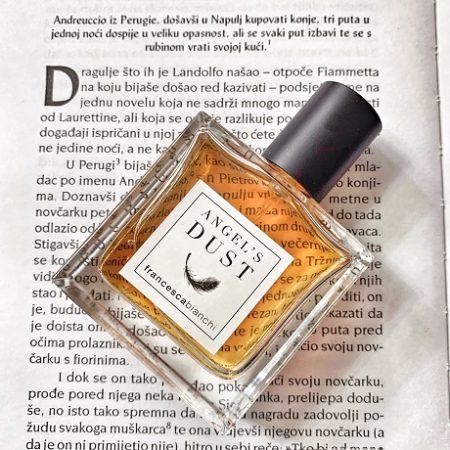
Francesca Bianchi Angel’s Dust, photo by Elena Cvjetkovic
Angel’s Dust / Francesca Bianchi Perfumes/ Francesca Bianchi: With its Tuscan origin and vintage references, takes you back to the times of Early Italian Renaissance… sweet and seemingly innocent, elegant, and smelling of the boudoir simultaneously. Angel’s Dust seems softly powdery, but beware… this fragrance was meant to seduce you without notice. A touch of fluffy winged angel covered in heavenly body powder, smiling sweetly at you. Innocent? Just give it time. It’s a sensuous floral with buttery-creamy iris and honeyed-resinous reflections on naked, musky, and pearl-like glowing skin. Who wouldn’t fall for that, even if far more experienced than our dear, naive Andreuccio?
Notes: black pepper, mimosa, rose, iris, musk, sandalwood, tolu balsam, benzoin, vanilla.
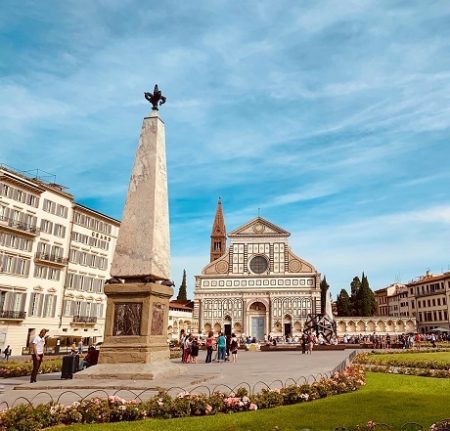
Santa Maria di Novella, photo by Elena Cvjetkovic
Just as the protagonists of The Decameron passed their time by telling stories, here at CaFleureBon we have been doing the same for you dear reader. Every day, day in, day out – new articles and reviews to bring you pleasure.
At the end of the Decameron, the storytellers all returned safely to the city of Florence after 40 days of quarantine, to the same place where they started: the church of Santa Maria di Novella in Florence – and so shall I. I promise.
Elena Cvjetkovic, Editor and Author of The Plum Girl
Disclaimer: Perfume samples/bottles were provided for my consideration by brands mentioned, or purchased on my own. Opinions are – as always my own.
Thanks to the generosity of Francesca Bianchi Perfumes and Francesca, there is a full bottle (30ml) of Angel’s Dust for one registered reader in the USA or EU (be sure to register or your comment will not count). To be eligible, tell us what you enjoyed or learned from Elena’s article, and where you live. Draw closes 5/20/2020
Support Small Businesses like Francesca Bianchi Perfumes. They need you now more than ever.
This is our Privacy and Draw Rules Policy
Follow us on Instagram: Instagram: cafleurebon the_plum_girl, acamporaprofumi_official, francesca_w,@santamarianovella1612
We announce the winners only on site and on our Facebook page, so Like ÇaFleureBon and use our blog feed … or your dream prize will be just spilled perfume.
